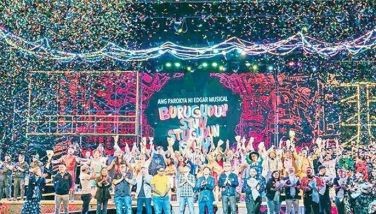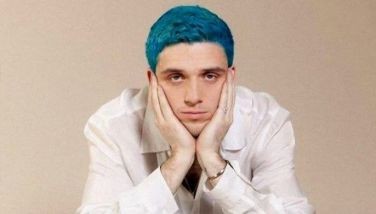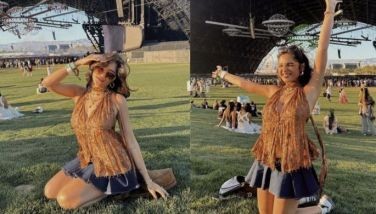Dances as dramatic denouement in cinema
MANILA, Philippines - The word denouement is derived from the Old French word desnouer, “to untie†and the Latin nodus, for “knot.†Thus, literally it is the unraveling or untying of the complexities of a plot. In comedy, the denouement finds the protagonist better off than at the story’s beginning, but in tragedy, it leaves him in a catastrophe, worse off than at the start of the narrative.
In cinema, there is a comic denouement in the final scene of Paramount Pictures’ Grease (1979) when vacationing Sandy Olsson (Olivia Newton-John) still ends up in the arms of local boy Danny Zuko (John Travolta) despite the many twists and turns of the T Birds and the Pink Ladies, especially in the Rydell High school dance, broadcast live on TV and hosted by DJ Vince Fontaine (Edd Byrnes) where Danny and Cha-Cha (Annette Charles) — who were once an item — end up performing together and winning. But as Shakespeare says, all’s well that ends well as in the School Fair finale with Danny and Sandy taking flight in the Greased Lightning car together, waving goodbye to their friends, singing We Go Together as the credits flash yearbook style.
But denouement dramatized on screen with a dizzying dance adds more frenzy to the falling action that finally rests in the resolution — lovers collapsing in each other’s embrace, friend comforting the significant other, or friends finally becoming lovers.
Oh perchance
When the last little star has left the sky
Shall we still be together?
With our arms around each other
And shall you be my new romance?
This line of courtly affection from the foot-tapping number Shall We Dance from the 1956 musical The King and I, starring Yul Brynner (as King Mongkut) and Deborrah Kerr (as Anna), brings to mind the poetry in motion that is the dance. When words fail to articulate the topsy-turvy beating of two hearts, give it to the dance as did Anna and the King of Siam in this much-loved story featured in the Rodgers and Hammerstein Broadway musical, based on the book Anna and the King of Siam by Margaret Landon.
The plot comes from the autobiographical story written by Anna Leonowens, who became the tutor to the children of King Mongkut of the kingdom we now call Thailand in 1869. The widowed English lady attempts to explain to the king the courtship rituals of the West and that young women are squired by young gentlemen at a formal dance. The monarch demands that she teach him and she obliges, and they waltz across the palace until she is breathless, her hooped skirt billowing as the virile king burns her with his gaze.
With hooped skirt billowing, too, Scarlet O’ Hara, still in her widow’s weeds, danced with the bemoustached Rhett Buttler in Gone with the Wind, a historical romance novel written by Margaret Mitchell, first published in 1936 and adapted into a movie in 1939 with Clark Gable and Vivien Leigh in the lead roles. The story is set in Clayton County, Georgia, and Atlanta during the American Civil War and Reconstruction. It dramatizes the saga of the irrepressible Scarlett O’Hara, the spoiled daughter of a well-to-do plantation owner, who must use her wiles and guiles to overcome the penury that shamed her family after Sherman’s March to the Sea, which also decimated Georgia’s aristocracy, born and bred in its cotton and slaves economy.
At the benefit dance for the Confederacy, men must bid for a dance with a lady and the notorious Rhett bids $150 in gold for a dance with the cunning belle of Tara who just married the unfortunate Charles Hamilton (who died of measles two months after marching off to war, leaving her pregnant) to spite Twelve Oaks’ Ashley Wilkes whom she adored, to the shock of the conservative Atlanta high society. Thus began their tumultuous love-hate relationship, ending in the now classic goodbye after their daughter Bonny Blue died from a fatal fall from her pony: “Frankly my dear, I don’t give a damn,†bids the ruggedly handsome West Point reject from Charleston, as the sentimental Tara’s Theme closed the curtains on the weeping Scarlett, who can only mutter: “Tara. Home. I’ll go home, and I’ll think of some way to get him back. After all, tomorrow is another day.â€
But the dance between friends who deeply care, specially when one is in the grips of sorrow and is about to cry is the conclusion of the Julia Roberts starrer, My Best Friend’s Wedding. The romantic comedy which was directed by P.J. Hogan, featuring Burt Bacharach/Hal David songs, including I Say a Little Prayer For You, was one of the highest grossers in 1997.
Julianne Potter (Roberts), a 27-year-old New York restaurant critic, receives a call from her longtime friend, sports journalist Michael O’Neal (Dermot Mulroney), telling her that in four days he will marry Kimmy Wallace (Cameron Diaz), a 20-year-old University of Chicago student from a rich media clan.
In college, the two made an agreement that if neither of them were married by the time they turned 28, they would marry each other. She tries her wickedest to break up the wedding but finally accepted the reality that her college boy friend has found the love of his life who was not her. She says sorry and was ready to lick her wounds in private, but her cell phone rings and on the other end of the line, a waltz away from her was her gay friend, George Downes (Rupert Everett), who asks her to dance her grief aside to the song The Way You Looked Tonight, with the tender comforting words:
Some day, when I’m awfully low,
When the world is cold,
I will feel a glow just thinking of you
And the way you look tonight.
During the heavily musical 2013 Academy Awards, host Seth MacFarlane sang the song (composed by Jerome Kern with lyrics by Dorothy Fields in 1936 for Fred Astaire and Ginger Rogers for the film Swing Time) while Charlize Theron and Channing Tatum performed an old-school dance, underscoring the dramatic tradition of the dance in cinema.
But what is better than two friends finally becoming lovers, and dancing in the street below their apartment window to the swelling aria of an opera, as when the clueless George (played by Jeff Bridges) finally discovered he loved the passionate Rose (played by Barbra Streisand) in the film The Mirror Has Two Faces. In her Literature class at New York’s Columbia University, the always-a-bridesmaid-never-a-bride Rose, lectured on what Jung theorized, that myths and archetypes are alive and well — (and living in her apartment):
“The question is, why do we buy it? Because, myth or manipulation, we all want to fall in love. That experience makes us feel completely alive. Our everyday reality is shattered, and we are flung into the heavens. It may only last a moment, an hour, but that doesn’t diminish its value. We’re left with memories we treasure for the rest of our lives. I read, ‘When we fall in love, we hear Puccini in our heads.’ I love that. His music expresses our need for passion and romantic love. We listen to La Bóheme or Turandot, or read Wuthering Heights, or watch Casablanca, and a little of that love lives in us, too. So the final question is: Why do people want to fall in love when it can have such a short run and be so painful?â€
Her students fish for the answer:
“Propagation of the species?â€
“We need to connect with somebody.â€
“Are we culturally preconditioned?â€
And she finally drops the bomb:
“ Good, but too intellectual for me. I think it’s because, as some of you may already know… While it does last, it feels — great.â€
Directed by Barbra (who was bashed in cyberspace for getting two not only very handsome leading men — Bridges and Pierce Brosnan — but younger than her), the romantic comedy interrogates the modern myths of beauty and sex and how they complicate relationships.
In one interview, Barbra confesses: “I’ve always been interested in telling stories about positive transformations and the possibility for human growth, about individuals who realize their potential and refuse to be governed by other people’s rules. I am curious about how love and compassion can heal and liberate the soul — send the spirit soaring.†And soar one’s spirit did as the theme song I Finally Found Someone played, with the credits crawling as dawn breaks in New York City, reminding the viewer when Aphrodite at last smiled on the once unloved Rose, who need no longer rue to her mesmerized class:
“As I stood at the altar beside my sister and her husband to be, it struck me that this ritual called a wedding ceremony is really just the final scene of a fairy tale. They never tell you what happens after. They never tell you that Cinderella drove the Prince crazy with her obsessive need to clean the castle (‘cause she missed her day job, right?). No, they don’t tell us what happens after because... there is no after.â€
But can we not wish that there is an after, as what happened after the King and Queen’s Ball of the film Enchanted, when two pairs of lovers switch partners to live happily ever after?
Enchanted is the 2007 romantic comedy musical film revolving on Giselle, an archetypal Disney Princess, who is forced from her traditional animated world of Andalasia into the live-action world of New York City. The film is both a paean to, and a parody of, conventional Disney animated classics, because here, it is the princess who rescues the prince from the clutches of the queen-turned-hag-turned-monster dragon.
Composer Alan Menken and lyricist Stephen Schwartz, who had written songs for previous Disney films, produced the songs for the fairy tale with a twist, which earned more than $340M worldwide at the tills.
The dizzying waltz by Giselle (Amy Adams, chosen by director Kevin Lima who wanted a lesser known singer-actress) wearing a purple modern gown and the divorce lawyer Robert (Patrick Dempsey) wearing a blue and white True Love’s Kiss ensemble, matched with the pair of Prince Edward (James Marsden) and Nancy (Idina Menzel) almost ended in catastrophe, when the evil queen Narissa (Susan Sarandon) grabs Robert and takes him to the apex of the Woolworth building. But the film culminates with another waltz, of the newly-married Giselle and Robert, who has found a loving step mother to his young daughter Morgan, and the denouement is immortalized as pages in a pop-up story book that neatly closes this film. As the theme track Ever Ever After (popularized by Carrie Underwood) exclaims:
“Storybook endings, fairy tales coming true deep down inside we want to believe they still do. And a secret is taught, it’s our favorite part of the story. Let’s just admit we all want to make it, too...â€
The dramatic denouement of lovers, friends and friends-turned-lovers tripping to the light fantastic was sung so well by the late Donna Summer on the year my husband and I graduated with our AB degree from UST in 1978, in the disco genre film titled T.G.I.F. (“Thank God it’s Fridayâ€), winning for her the Academy Award for Best Song in 1979. Starting the Paul Jabara song as a lamenting ballad, Donna swings it into a heart-thumping fast tempo that syncopates all the bliss and tender mercy of holding someone in a light embrace to the lilting music that sweeps the partners off their feet to a far away dream where love, loyalty and longing harmonize in a sacred ritual of the dance:
Oh, I need you, by me,
Beside me, to guide,
To hold me, to scold me…
So let’s dance, the last dance
Let’s dance, the last dance
Let’s dance, this last dance tonight…
- Latest
- Trending


























 Exclusive
Exclusive

